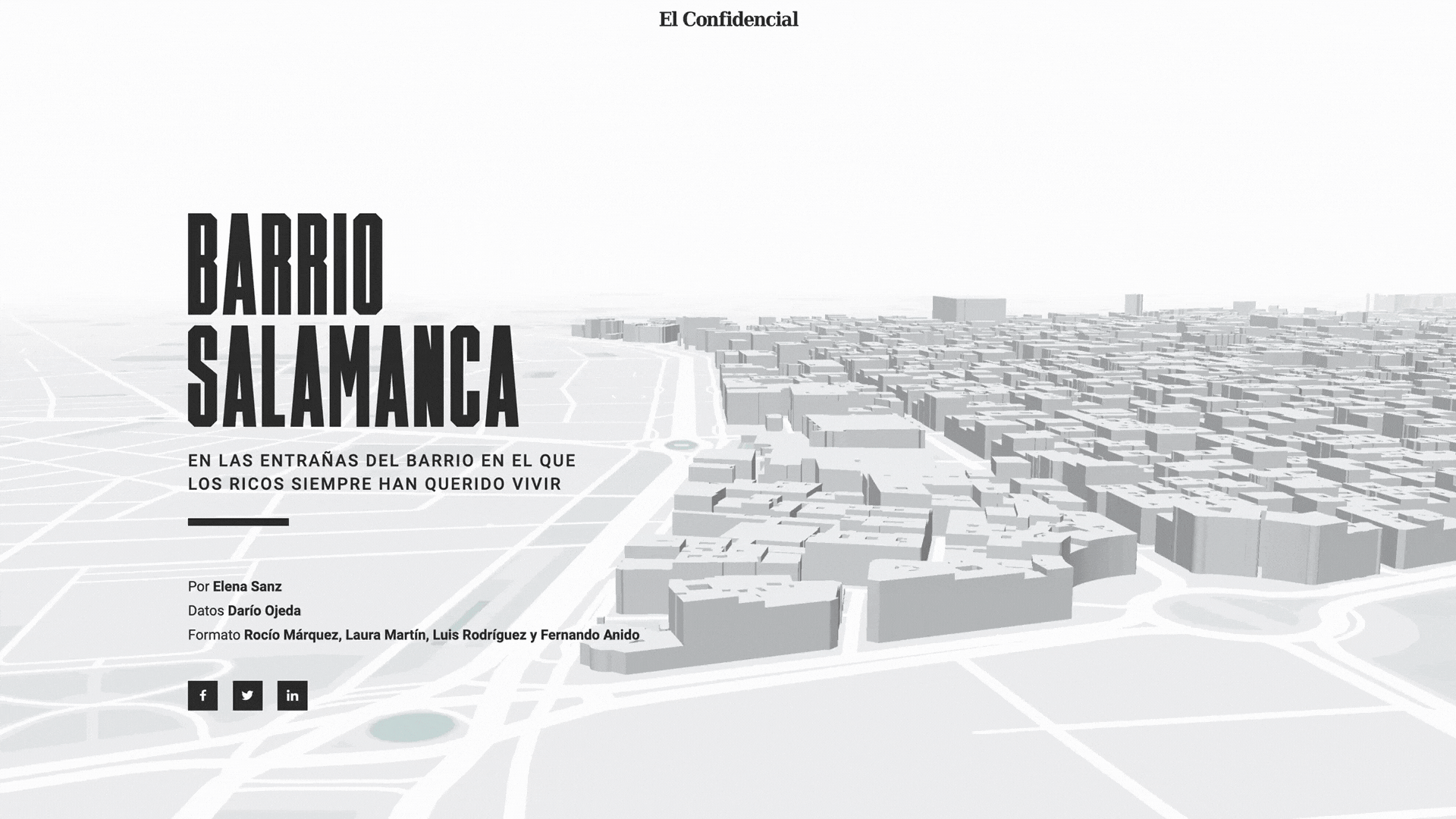All she wanted was a photo of the new-born babies and asked that István and Tamás love the twins
When we began this story, I was still having treatment to get pregnant by artificial insemination. It can be a deeply depressing process to go through: you think, what happens if this doesn’t succeed? Would I be capable of, say, adopting? Would I be able to love a child who might have had a terribly tough background, arriving with a “package” that I would have to deal with. The straight answer, I think, is that even now I couldn’t do it, even after seeing close-up what a chance the twins received when they were adopted by István and Tamás.
I began documenting the life of the family with my colleague Orsi Ajpek because we thought it was important that people become better informed about rainbow families like this one. As a family, they may be unusual, but they live the same kind of ordinary, everyday life that any heterosexual family lives. It’s just that in Hungary the circumstances have radically changed in the past few months. There have been a series of legal changes that have made adoption by single parents and same-sex couples all but impossible, followed by the “paedophile law” that explicitly incited hatred towards gay people.
About a year ago we talked to István and Tamás about how absurd it was that the 40-hour course to prepare would-be adoptive parents was no longer mandatory. Now we are talking about whether the time might come where the family packs its bags and finds another more welcoming country in which to bring up their children.
In Hungary, it is unusual for a rainbow family to put their lives in the public eye. István and Tamás don’t want to become a visible target and are protective of their privacy. They have their own everyday struggles as adoptive parents. Nevertheless, they decided to show themselves so that those who attack gays and rainbow families out of ignorance can see how they live. Perhaps through this article people can understand that “these children are not suffering in chains and their parents don’t spend the whole year frolicking around in pink thongs in preparation for Pride, but in fact live ordinary lives”. Another factor was a wish to help young people who think that their lives are at an end because they are not heterosexual. They want to set an example for them and give those people hope. If reading their story changes the opinion of just one parent and encourages them to support their homosexual child, then the publicity has been worth it, the two fathers say.

We arrive in the residential district of a small town in Pest County and for the umpteenth time park in front of their house. The twins are tottering in the doorway waiting for us, but there has been some drama and it is hard to say which of them has bigger tears rolling down their face.
“It has been one of those days,” says István with an air of resignation. The magic of our arrival quickly loses its effect and the two children continue crying in unison while demanding to be picked up and allowed on to their dads’ knees. But lunch needs to be prepared. It’s mushroom and paprika stew and between stirring István gives hugs to first one and then the other, and sometimes to both at once, to calm them down. He doesn’t despair — it’s the most natural thing in the world for him to be the father of two children. For as long as he can remember he has wanted this with Tamás.
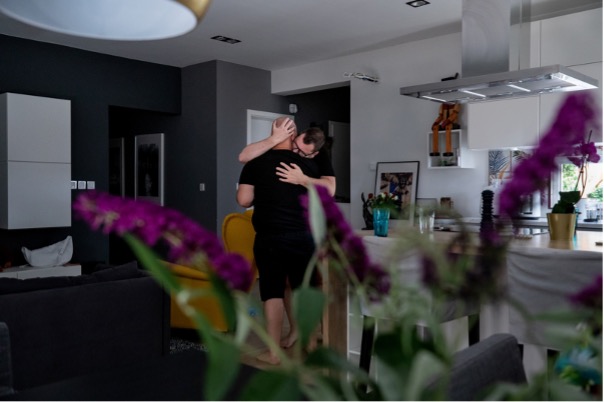
For seven years, starting in 2012, they actively tried to become parents. They had been living in the Scottish city of Glasgow for two years. They got married in 2016 and wanted to settle down there, but in the end they came back to Hungary. One reason was that they hadn’t been able to adopt there. They wanted to have children so badly, and initially even contemplated going down the illegal route. No time or money was spared in exploring every possibility, including methods that we outsiders can only guess at.
They described the surreal world constructed around those who will give anything to become a parent. A huge amount of money changes hands and there is a real battle for potential surrogate mothers. They were in discussions with Portuguese, Ukrainian, British and Hungarian surrogate mothers but had also considered the Czech Republic, Congo and South Africa. The Ukrainian surrogate mother would, for a larger amount of money, have used her own eggs to have their children. One Hungarian woman offered to do it for 5 million forints (€14,000) but they didn’t go through with it. They say that at first it seemed like the easier option to pay to become a parent, but it isn’t. “What do you say to the child about how much you paid for them? The price of a small flat?” They felt that that none of these ways would work.
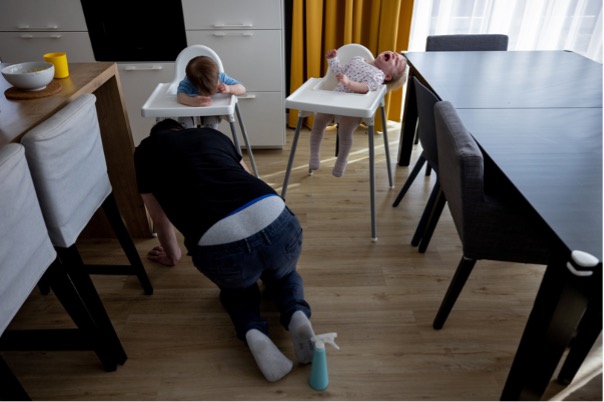
They finally decided that the official adoption route was the only acceptable way to go, which in Britain is a far longer and more complicated process than in Hungary. For six months they had to have monthly meetings with the social services. “We had to write essays, we had compulsory reading, we were interviewed separately and together, they asked for references from friends and employers” — they list the hoops they had to go through.
It was all going smoothly until Brexit completely jammed the process. In spite of the strict procedures they had followed they did not get approval for adoption. The problem wasn’t that they were two men, but that everything changed after Brexit.
“The biggest concern was that we would take the child away from its roots. It was very hard to explain to them that we hadn’t come from a Communist country.”
In the end their application was rejected because they were young and were studying alongside their work, so were not considered ready to be adoptive parents.
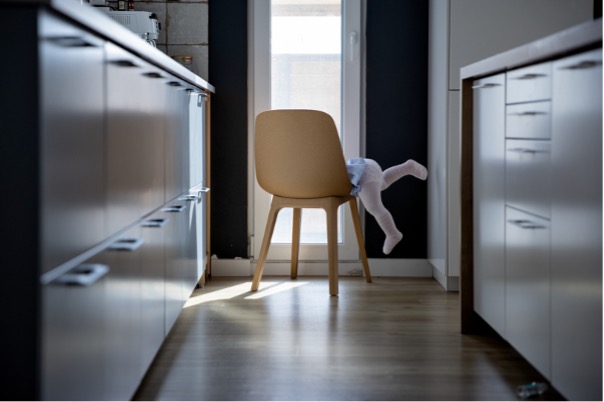
They had already decided to go back to Hungary if they didn’t get approval in Scotland. They moved back in 2017, but still had not given up hope of becoming parents. In Hungary it wasn’t possible even then to adopt as a same-sex couple, but a single person (ie, not married) living with a registered partner could adopt, regardless of their sexual orientation. They agreed that István should make the application. This was a conscious choice, as was the decision before they got married that they should take each other’s name, so that any children they did have would bear both their names.
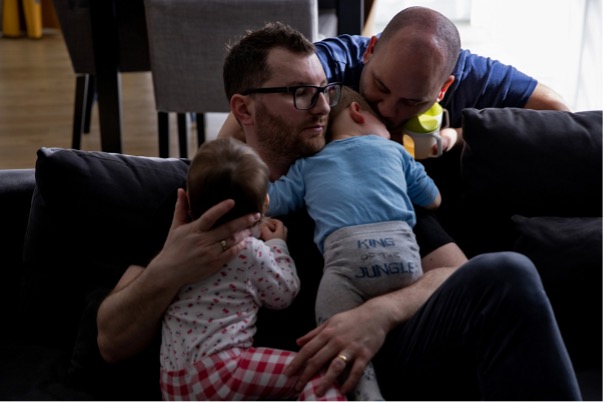
In early 2018 they applied to the Regional Child Protection Service (Tegyesz), which came to inspect their home and their circumstances. The couple went through the compulsory psychological assessments and completed the preparatory adoption course that was then mandatory.
The psychologist working with István said they generally recommended that a single would-be adoptive parent take on a child of the same sex, but István and Tamás asked for that not to be the case.
“We gave our reasons why we could also bring up a daughter. We said we understood the importance of a female model for a child’s all-round healthy upbringing, but we said this did not necessarily have to be the mother, and there would be grandparents, aunts and cousins around the child who would fill that role.”
Their arguments were accepted and at the end of 2018 they were given approval for adopting “a 0-4 year old child or twins” with no restrictions regarding their sex or background.
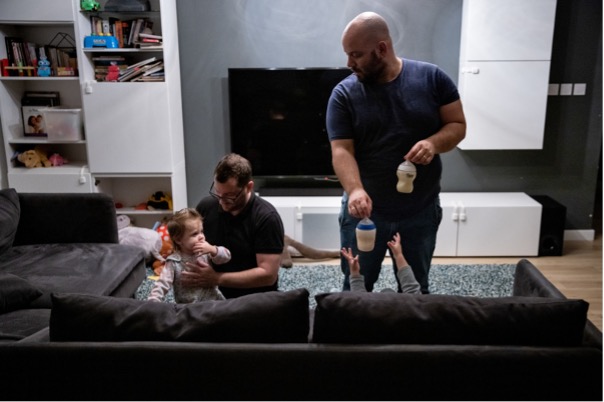
It was compulsory from 2003 onwards for would-be adopters to take part in a preparatory course. This 20-hour course was extended to 40 hours in 2018. This gave more time to cover important subjects such as connecting with children, the question of the child’s background, adopting older or disabled children and the handling of loss, according to Zsófia Kiss, a specialist psychologist. She runs courses for the Ágacska Foundation, which specialises in adoption. Alongside her birth daughter she has an adopted son, and often draws on her own experiences so that she can more convincingly prepare couples for adoption.
The aim of the course is to prepare the adopters so that as little as possible takes them by surprise. They cover the areas that are defined by genetics which adopters certainly cannot change. For example, genetically defined characteristics include the colour of their skin and eyes, their temperament, skills, capabilities and inherited diseases.
“However, the child’s behaviour and values are defined by its environment. There is no such thing as a stealing gene or a lying gene. Empathy can be taught,” Kiss says.
István and Tamás often came across these stereotypes when they intentionally prepared their friends and family members for the fact that there was a good chance that “Gypsy children would be running round the house”. This caused some serious debate when some acquaintances joked that they would have to hide their wallets away. But the couple also heard people say that if they adopted Roma children, “sooner or later their blood would show through”.
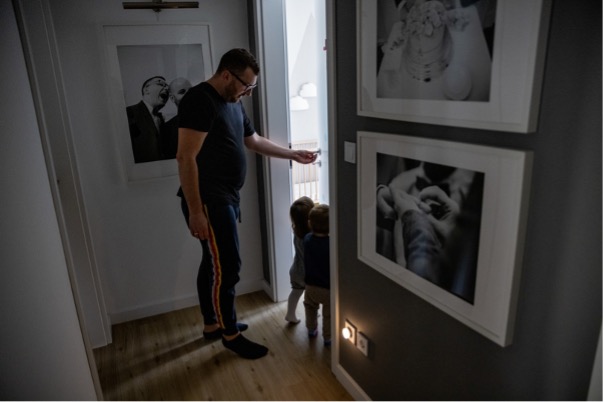
The majority of adopted children are born from unwanted pregnancies and have not received proper care in the womb. “The mother may have been starving or undernourished; she may have smoked, drunk or taken drugs — but it should be noted that generally it is not the mother’s fault that she finds herself in this position,” says Kiss. All such behaviour affects the embryo’s nervous system. An underdeveloped nervous system can be a factor in the neurological and psychiatric states such as ADHD, concentration problems and delayed speech development, which cannot be cured but can be handled. Adopters need to be prepared for this.
“We don’t want to shock them but we tell them everything that could arise, which of course doesn’t mean that it will,” the psychologist explains.
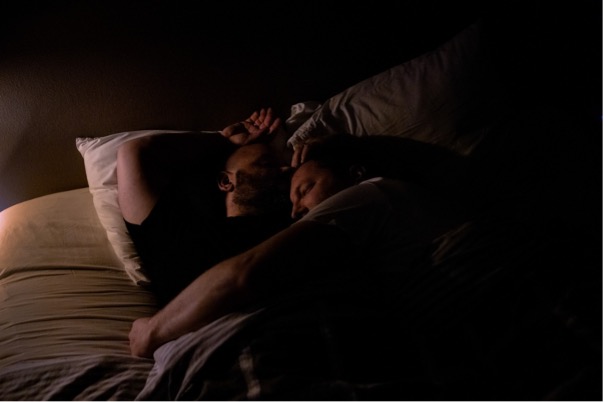
Adoption is often preceded by loss. Typically, adopters have not themselves been able to have biological children, and at this point the great majority resort to medical help. When that also proves unsuccessful the would-be adopter is already burdened with a considerable sense of loss. This loss has to be processed, Kiss says, because the adopted child has its own losses which also have to be handled.
“If I am not well myself, it will be harder to help others. If I am still feeling that it is a blow of fate that I couldn’t have biological children, and if I go into adoption with the sense that “If I can’t have a horse, I’ll make do with a donkey,” that is a huge trap. The child will grow up in the shadow of this idealised biological child that I am still clinging to,” Kiss says.
It is not only heterosexual couples that have to struggle with loss. István and Tamás had to abandon their hopes of having a biological child because of the legal system in Hungary. “If we had gone in for adoption in a different country, we might have been able to go through surrogacy. But even if we had got round Hungarian laws and had decided to live in a mosaic family, having children with a lesbian couple, we still did not want to be ‘weekend fathers’,” they say.
They also had to accept that their adopted children won’t bear any of their own features, but they say that they can see their gestures and habits in the children. “Our daughter sleeps in the same way as Tamás, and like him hates labels in her clothes,” they say.
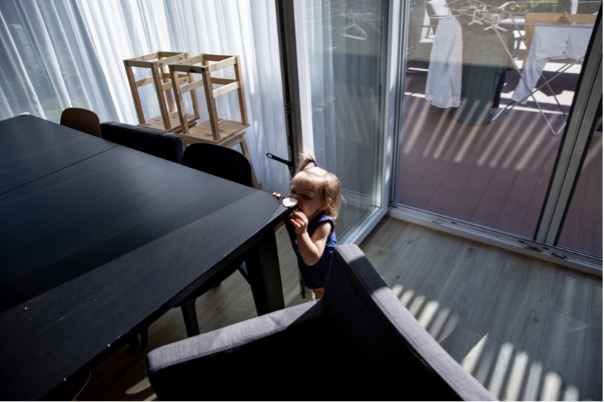
The government modified the legislation on adoption last year. In theory this aimed to simplify and speed up the process, so that more children could find families quicker. Children in the child protection system can be adopted after three months instead of six months if their birth parents take no interest in them. The 40-hour preparatory course that had been mandatory was made optional and free, a move that aroused strong protest.
“To be frank, we wouldn’t have gone on the course if it hadn’t been compulsory. We thought that we knew it all,” Tamás says. However, they acknowledge that they learnt skills on the course that helped them through the harder moments. For them the course was the most useful and most important part of the adoption process, “because a 3-year-old can’t hear that they have been rejected. One can involuntarily think or even actually say such things,” István says. “One of our very kind friends asked — in tears, with the best intentions: ‘How can people reject them?’ I explained that these children have not been rejected, they have been looked after. The child who has been rejected is the one found on a lakeside shore in a plastic bag.”
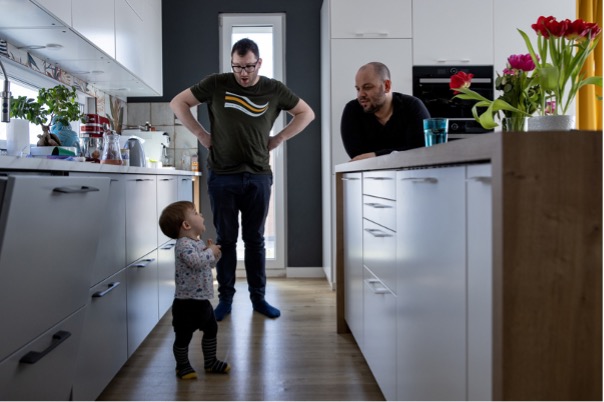
However, making the course optional is not the main problem, say the dads. Now basically only married couples have a chance of adoption — the decision over whether unmarried people (or same-sex couples) can adopt “in cases deserving of particular merit” lies in the hands of one single person, the minister of family affairs. In the modified legislation, children that are up for adoption must first be offered to married couples in the same county. If that doesn’t succeed, the search is widened to include married couples elsewhere in the country. If that is also unsuccessful, then the search is opened up to single people, first at a county level and finally at a national level. The children that are available for adoption at that final stage are those that were turned down by heterosexual couples. If the minister decides that a child should not be given to a single adopter, the case can spin out and the child can get stuck in the system. So effectively adoption has become harder for the very people who were typically the most likely to undertake the upbringing of older or more problematic children and those with a more troubled background.
‘Those who are most welcoming are the ones in this system who for the bloody life of them won’t be given children. And that is not fair. Why is a single parent worth less than a heterosexual married couple?” István and Tamás ask.
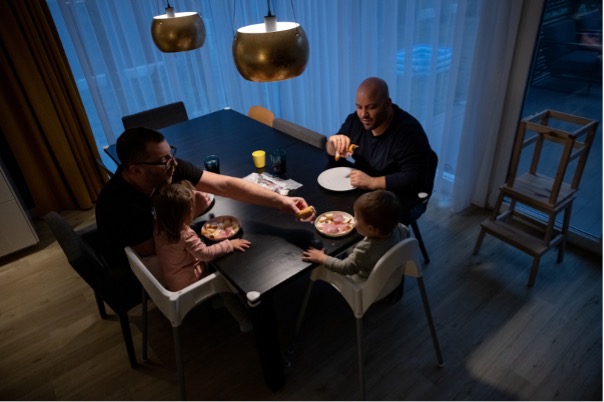
Once the couple received their approval, they didn’t even dare go on holiday, they were so anxiously awaiting the phone call. On the advice of friends they signed up with an adoption agency. Such agencies operate on certain conditions. In Hungary there are two agencies that deal with single parent adopters — in exchange for an annual membership and a commission.
In September 2019 the head of the agency finally rang them to say a woman had chosen their profile. After the second call it turned out that it was opposite-sex twins.
“They told us the woman was 32 weeks pregnant and was about to give birth. We were given their background, their little ‘package’, and told to decide,” István says about the second phone call. He says it was not an utterly difficult “package” but there were “some things in it”. No one other than the couple themselves knows exactly what it contained, and they have deliberately not told anyone, even their closest friends. “Our story begins with the phone ringing. What happened before that is the babies’ story, which we will tell them one day. It is up to them if they want to talk about it then,” Tamás says.
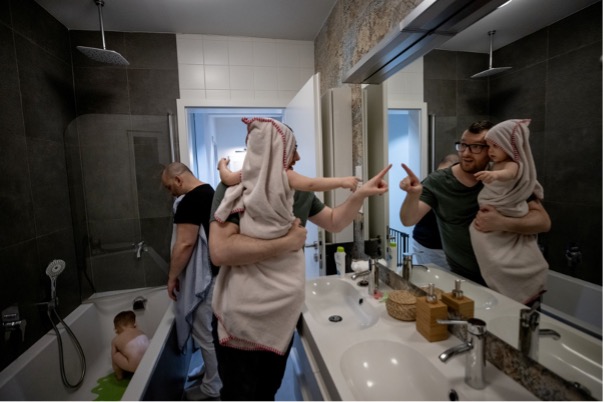
Since it was an open adoption process, István and Tamás met the twins’ biological mother. They say a meeting like that is both incredibly depressing and uplifting, and it was the agency boss who got them through the more awkward moments.
“Even after the children are born you are full of doubts. You are afraid the mother will have second thoughts, while she is afraid you won’t like her children and will change your mind.” They both describe her as an attractive and kind woman. They have a positive image of her, which they say will make it much easier to talk about her with the twins later.
“We don’t want to embellish the story but we can give a positive image of her. That is how we have to discuss the whole thing, because these children, like any adopted children when they reach a certain age — whatever you do — feel rejected. These children weren’t rejected, because their biological mother worked hard to make sure they would be all right. She took care of them.” By getting in touch with the agency, she gave them a chance. She asked that they should go to a house with a garden, to a family without other children, and she explicitly said she wanted a gay couple to adopt them. The agency also offered her heterosexual couples, but István and Tamás were the first that she met.
“We reassured her that if she chose us, we could promise her that we would give our lives for these babies and we would do everything we could to make sure they have a good life.”
István and Tamás particularly wanted her to choose the children’s names. When they had their first meeting, it turned out that she had already chosen names. It was one of the most touching moments when she said the two names, because suddenly it gave a personality to the two children. After that meeting, the mother did not want to meet any other couples.
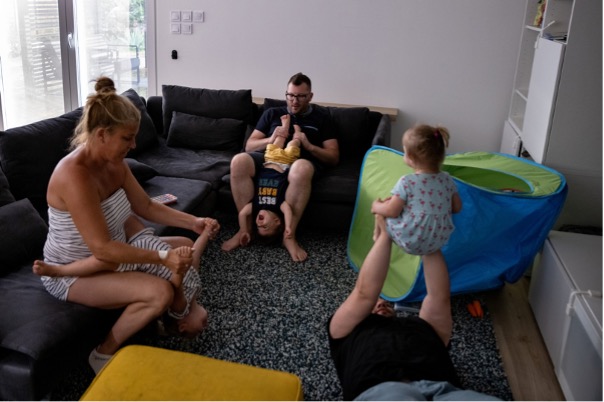
The twins were born in the 35th week, at the end of November 2019. “After we saw the babies, the head of the agency asked us again if we intended to go ahead with the adoption.” István and Tamás of course burst into tears and for the hundredth time said yes. The agency sorted out all the official paperwork and registered the children with the local authority, where the mother had to officially declare that she was giving up the children and entrusting them to István and Tamás.
“This was a very agonising situation. The official explained to her that she could still change her mind, and would have six weeks to do so,” István says, looking back.
When the dads said goodbye to the mother, they asked if she would like to keep in touch with them. She didn’t. She said she found this all very painful. All she wanted was a photo of the new-born babies and asked that István and Tamás love the twins.
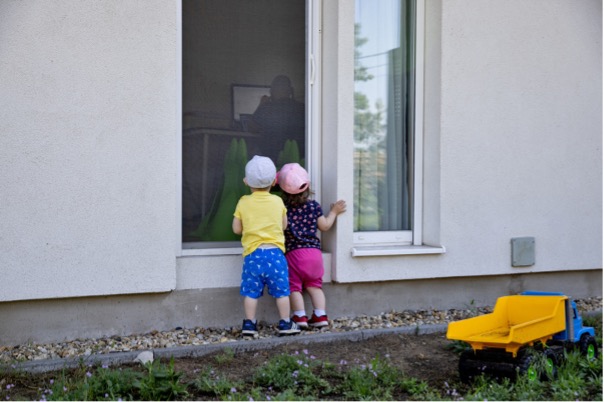
The six-week period after a temporary placement ruling allows both sides the chance to change their minds. The head of the agency told the couple they should only get in touch if there was a problem.
In practice they didn’t have time to count the days. After one week the boy was admitted to hospital. He wasn’t eating much and was crying at such a pitch that they knew something wasn’t right. The hospital’s first reaction was that “the gay dads are overreacting to a trapped fart. The baby has colic.” But the inflammation indicators were so high that the doctors suspected meningitis. They were allowed home after a week, but it was never clear what had caused the inflammation. The couple say that it never occurred to them to pull out of the adoption. That time in hospital just confirmed that they really were a family.
The critical six weeks ended in early January 2020, and the mother did not change her mind. “Those last few hours were very difficult. I sat looking at the clock, wishing the time to pass, wishing it to be midnight. At midnight we went into the children’s room and told them that they were staying with us. It felt so good,” says István.
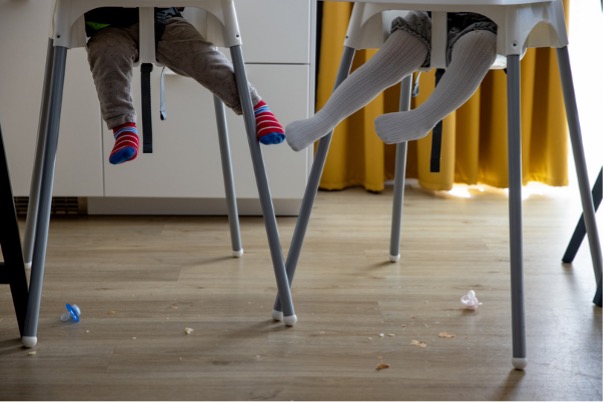
The dads wanted the children to have a definite female presence in their lives and to this end choose two godmothers who would be a part of their everyday lives. However, until they went to kindergarten the twins spent most of their time with István, while Tamás went to work. István spent more time with the twins, staying awake with them at night if they were ill, or reading up about weaning, and this awoke a sense of fatherhood earlier in him. For Tamás, the week-long stay in hospital with his son was an important turning point. Even though it did not bring a sense of fatherhood, it did awaken a sense of responsibility. “From then on it was totally clear that this child needed protection. We bonded that week, during those long nights,” says Tamás.
For both men, becoming a father has been a long process. “There comes the time when you are important, when only you can calm a child, when the child will only accept things from you. Those are the moments when you begin to feel that you are a parent, a father.”
The dads say that they have no traditional roles in the house. “We are equals, there is no division of roles. We each do the tasks we are better at or prefer doing. I am a much better cook, for example, but Tamás is better at cutting hair.” So István became Daddy while Tamás is Dad. It was one of the defining moments when the children identified them using those two words.
They have a lot less time for each other and their lives have changed: the focus is on the children, who they bring up with amazing humour but with consistency. It is such an idyllic environment that Orsi and I have noticed that we visit them to recharge our batteries.
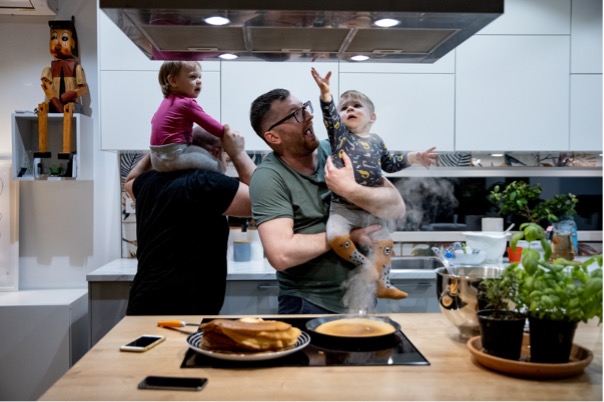
The two men have the kind of solid bond that it is rare to see in a relationship. They generally uphold traditional values in their parenting — they are pretty strict when it comes to eating, sleeping and watching television. Even so, there are times when we are run ragged, getting up at night or both kids screaming at once, even though of course it is the children who made the family complete.
“The first couple of weeks were very easy. They woke up every four hours, had some food and went back to sleep — and we wondered, is this it? Then suddenly they began crying and staying awake for longer and longer,” they recall. István and Tamás went through the same low points and doubts as any first-time parents.
“For eight years we had been trying to have children, we had done all we could, and then these two miracles arrived. But when you are up every night for three weeks you do ask yourself — and the fact that the question arises makes you feel bad — whether you are doing it right, whether this is what you want. And then you turn the corner. We were sitting there in the third week and I was rocking the little boy. I told him to give me a sign there is some point to all this, and he broke into a little smile,” says István.
Of course it hasn’t got much easier since then. The baby boy reacted much more strongly to stimuli, he was more sensitive and everything was more of a drama compared to his sister. He needed special exercises to develop his movement, but he has caught up completely. Now there is real competition as to who can dive more quickly onto the sofa, or who will pull the other round the kitchen island on the toy truck. So their lives are pretty much like that of any other family of twins. With one difference. Right from the start the dads have told the children that they are adopted.
“You instil an awareness of that— it’s not like that one day you sit them down and you tell them. You have to make the children aware that this is not a taboo subject, that this is something they can talk about.”
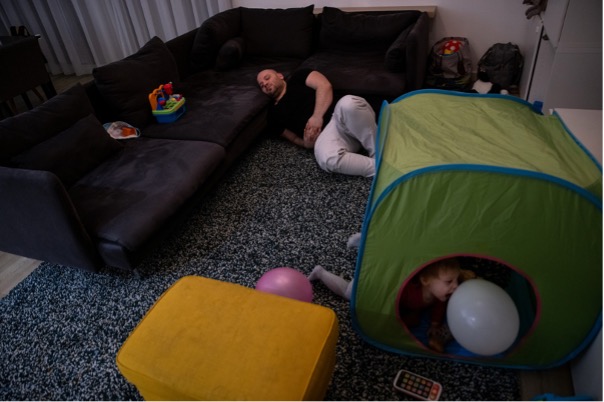
Zsófia Kiss says they recommend that parents find some form of positive expression for this. For example, “It’s so good we adopted you, as that makes the family complete.” What you might say will vary as the children get older. “By the time they go to nursery, they should be clear that they were from another woman’s tummy and were then adopted. As they develop, they will ask more questions about what happened and why they were adopted,” says the psychologist.
You won’t be able to get away without the child asking if their biological mother was a sex worker or was raped. “They could hear this from someone else, and the secrecy can drive a wedge between parent and child. You might need to call in a specialist at this point, since the story of their biological family is an integral part of their whole self-image. “You don’t have to embellish it, you just have to relate to the child’s biological roots acceptingly.”
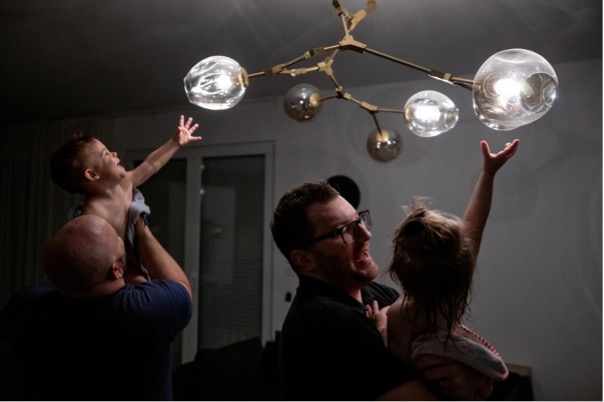
Also, it cannot be a taboo subject for the kids that István and Tamás are gay. “For them it will be natural that two people love each other, regardless of their gender,” says István. From the start the dads have smuggled in tolerance, acceptance and different family combinations into the twins’ lives. On the bookshelves, alongside traditional Hungarian children’s stories are books such as And Tango makes three, about two male penguins who create a family together.
István and Tamás say that ever since they were kids at nursery they were both more interested in boys than girls, but for many years they suppressed these feelings, mainly to live up to social expectations. Tamás says he did not want to stand out. He buried himself in his studies, tried to look “more manly” and to have dates with girls. István was having his own struggles. “I thought this was terrible, I so loved my mother and sister and felt they didn’t deserve such a bad family member.” He knew he had to keep it secret. He was constantly struggling with this and felt totally alone. He planned that he would have a wife and children but would lead a parallel life. As a teenager he did wonder if he should just end it all and then he wouldn’t hurt anyone.
However both of them came to the decision that they could not live like this. It helped that both of them could go to gay bars that had opened, where they discovered there were others like them. They also found more information on the internet. For István, the turning point was when a gay guy asked him: “You do know that you too have a right to happiness, don’t you?”

They say that it still isn’t easy talking about that period, not least because they don’t want to reopen old wounds. They know that it was just as hard for their parents to process the fact that their sons were attracted to men as it was for them. “We were smashing their dreams of a wedding and having grandchildren. It makes a parent blame themselves. Why didn’t I notice? What did I do wrong? Of course, the answer is nothing.”
István came out to his parents when he was 21. Tamás was 24 when he met István at a party in 2008. “It was love at first sight, the way we connected that evening,” he says. They started dating and then moved in together, but Tamás only introduced István to his mother and brother after they had been together for a year. He had never told them before that he preferred men. It took a while for the family to accept the situation and tell others.
István’s position is more complicated, as some of his family are less accepting. Until he was 30 he played along with this, and never spoke in front of his relatives about being attracted to men, though clearly everyone knew. It was just easier for one and all to keep quiet about it. For a while he brought Tamás to family lunches, but in the end it was just too awkward. He has completely lost touch with some of his relatives because of his relationship, but there are others who have become much closer since the arrival of the twins. The one person who they were most afraid would not be able to handle the children’s arrival was István’s grandmother. But she has been one of the most welcoming in the family, and was perhaps even more excited about them than the dads.
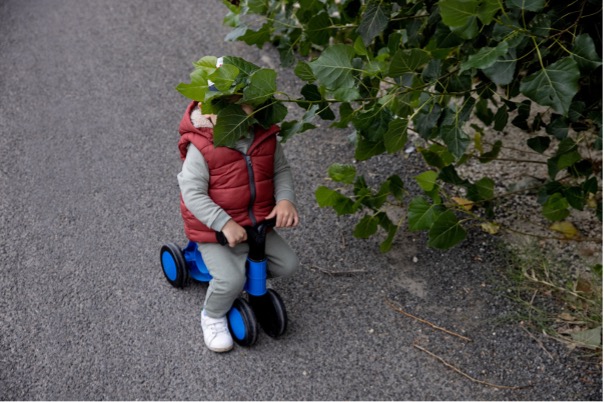
The couple do not usually get involved in political affairs, and they don’t like to mix family relations with politics, but the subject of the government’s policies come up increasingly often. They had never really paid attention to which party people voted for, and politics was never discussed at gatherings of family or friends. However, the anti-gay legislation has changed that. It particularly worries them as they are now a same-sex couple bringing up two children. “I’m concerned about the safety of my children. I didn’t care when it was just me being abused or spat at in the street, but now they might do it to my children,” says Tamás.
It would be painful now to find out that someone close to them has voted for the government. “That decision would effectively legitimate this whole madness — it would effectively be a vote against my family,” he says. They admit that if the government passes more legislation that makes their family’s life impossible, they might have little choice but to leave.
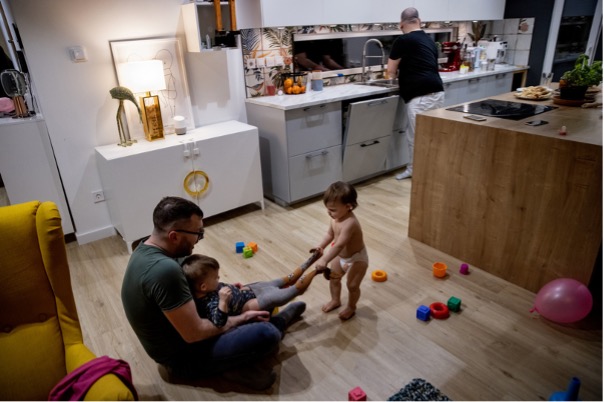
They feel that there is active incitement against gays in Hungary, although in their immediate environment they have not met much resistance. So far no one has created difficulties for them because they adopted as a same-sex couple. Their strategy is to take it as given that they are a rainbow family. They undertake the battles so that it does not make things harder for their children.
“We went into the kindergarten and told them that we are one family with two dads. We will do the same at the nursery and later at school.”
The health visitor “didn’t bat an eyelid” when Istvan told her the children did not have a mother, and in the kindergarten, where the children began at the end of October, the staff didn’t make any comments — on the contrary. The head didn’t cause a problem when it came to filling out the parts of the forms referring to the children’s mother.
The dads want to bring up the children so that they know how to defend themselves. “If they are self-confident and take it as natural that they have two dads — and what’s more feel good about being in this family — when anyone tries to make fun of them it won’t faze them.”
“We want to teach them to be tolerant, to understand that if someone hurts them, it’s not necessarily because that person is malicious — he or she might be just ill-informed. They need to learn to communicate with and educate those around them,” says Tamás.

The dads were preparing for the twins’ second birthday for months, with a separate Facebook page, a present list, a three-tiered cake and enough balloons for a wedding. They wanted the perfect party as the pandemic prevented them from celebrating the children’s first birthday the way they wanted to. It all happened just the way they wanted, a big party with family, friends and lots of happy children. “As a parent it is very important — and it’s a very good feeling too — if lots of people like your children. And lots of people like ours.”
Barrio Salamanca
It is the ‘prime’ area par excellence of the residential market of Madrid luxury. We are talking about the Salamanca neighborhood, whose origin dates back to the second half of the 19th century and whose history is inextricably linked to two figures. Carlos María de Castro, one of the great Madrid urban planners and architect of the Madrid expansion, and José María de Salamanca y Mayol, Marqués de Salamanca, one of the great landowners of the eastern expansion, where the Salamanca neighborhood was located. The latter was one of the main promoters of a neighborhood (in fact, its name is due to him).
The neighborhood was initially called upon to accommodate the Madrid middle class, but it ended up receiving the nobility and high bourgeoisie of the 19th century and becoming the true heart of the Eixample East due to its rapid organization and provision of services compared to the rest of the areas of Madrid.
In fact, as Borja Carballo Barral explains in ‘The origins of Modern Madrid: El Ensanche Este (1860-1878)’, “the new infrastructures and public services became a reality at the same rate that the buildings flourished”.
From that moment on, interest in living in the Salamanca neighborhood of the wealthier classes has only grown to this day, especially among the rich Latin Americans, and among them, among Venezuelan buyers. A huge appetite that is concentrated in just a handful of streets, which undoubtedly makes it difficult to find not only buildings, but homes that meet the high demands of these buyers, since, although since 2014 there are several rehabilitation projects that have been carried out in the neighborhood, in general they are very old houses and buildings, some of them with almost two centuries of history.
“Salamanca is the favorite neighborhood for Latin Americans who want to have a ‘pied-à-terre’ in Madrid as a bridge to Europe. This type of client values restored classic buildings, if possible with ‘amenities’ and parking spaces, and is willing to pay more to have a premium location close to fashionable places. In addition, the Salamanca neighborhood encompasses the entire most cosmopolitan area of Madrid, where luxury shops and trendy restaurants are located. It is the luxury neighborhood par excellence”, highlights Elena Jori, director of Real Estate at Home Select. “Salamanca and Jerónimos continue to be that ‘object of desire’ for every Latin American investor and a house in Alfonso XII is like being on 5th Avenue contemplating Central Park.”
“The consolidation of the Salamanca neighborhood in recent years as the preferred place for Latin Americans both to live or to spend time has been a natural evolution, since, in a sufficiently large space, at the same time central and very comfortable, they have it everything close and with a lot of variety in every way. Starting with a wide range of restaurants, luxury ’boutiques’, clubs, neighborhood shops and even El Corte Inglés together with very good communication with the rest of the city, airport or train, and with the ease of being able to walk, while in their countries of origin or in cities like Miami they always depend on the car. And let’s not forget the Parque del Retiro, the jewel of the neighborhood and its proximity to it, which is always a plus to keep in mind”, says Luis Valdés, ‘managing director’ of Residential Sales Advisory in Colliers.
In the Architecture Guide of the College of Architects of Madrid (COAM), a database that collects the history of the most representative buildings in the city, there are cataloged about 120 buildings for residential use in the neighborhood, whose construction date dates, in some cases, to the recently released second half of the 19th century, that is, at the height of the construction maelstrom of the Marquis of Salamanca.
Why the Salamanca neighborhood
Why the rise of the Salamanca neighborhood? Why did the bourgeoisie concentrate there and not in other areas? Part of the explanation has to do with the neighborhood’s infrastructures and services. And, in the case of Salamanca, this was a really differentiating aspect compared to other areas of Madrid. Why?
The status conferred by living in the Salamanca neighborhood has remained in force to this day. Although this was not always the case, since, in its origins, bankers, large merchants, rentiers or large owners preferred to live in the old part of the city. Little by little, and especially after the arrival of the tram to the streets of the Salamanca district, a good part of that high bourgeoisie began to abandon the old town in favor of the luxurious houses of the new district.
In fact, the Marquis of Salamanca was key in the arrival of the tram. In 1871, with the help of British capital, he launched “the first tramway in Madrid that linked the Salamanca neighborhood with that of Pozas through the Puerta del Sol”, Borja Carballo Barral recounts.
In 19th century Madrid, the greater the number of buildings built in a neighborhood, the greater the share of income from land tax. Some income that, as Borja Carballo relates, was invested in the new public infrastructure that the neighborhood needed. Which, as he explains in his academic work, “in the long run became the main mechanism of segregation and social compartmentalization in the development of the Ensanche de Madrid”.
And it is that, as the author explains, “the ruling lay in the fact that the land tax paid for the new buildings was recorded based on the quality of the buildings and not the number of rooms or the number of tenants that could In this way, those neighborhoods that had more luxurious and ornate buildings, but that housed a smaller population, as in the case of the Salamanca neighborhood, had a larger income account with which to deal with the payments of the infrastructure works and public services. On the other hand, those spaces of the expansion in which most of the popular classes resided, always maintained a reduced capacity to carry out the necessary public investments”.
Vertical segregation
Unlike what happens today, at the end of the 19th century, the different social classes could come to live not only in the same neighborhood, but in the same building, although the nobility used to live in their own palaces. There was what experts have called vertical segregation.
“All the large industrial landowning families moved to the Salamanca neighborhood, the luxury neighborhood par excellence. The wealthy families built large palaces (Linares, Zabálburu or Arenzana), but buildings were also built where the middle class could live and even the lower middle class. Not surprisingly, until the elevator was invented, different social classes coexisted in the same building. As you went up the floor, the classes were less affluent”, explains the architect Carlos Lamela.
The Palace of the Marqués Linares (1863) is a characteristic example of 19th century Madrid palatial architecture. It was abandoned for a long period of time, and was even threatened with demolition, according to the COAM Architecture Guide. In 1976, however, it was declared a historical-artistic monument and was acquired by the Madrid City Council. Currently, it is the headquarters of Casa de América.
It was very common for the owner of the building to establish the main residence on the first floor —on many occasions with its own entrance— and allocate the rest of the homes for rent. Obviously, as you went up in height, the rents varied. A century and a half ago, the higher the altitude, the lower the rent paid. Example of a rental in a building in the Salamanca neighborhood. Salustiano Olózga, 6. 1878. Page 237.
“The upper floors, the basements and the attics were the exclusive predominance of the day laborer families, mostly of immigrant origin who could only afford to face the cheapest rents. The floods of immigrants As they flowed towards the capital, they settled in those areas that were most affordable for their meager coffers, whether in roof tiles, inns or in the attics or basements of the new buildings erected”, Borja Carballo relates.
“It is very curious that, back in the 19th century, the service lived on the highest floors of the buildings and the families on the ground floor. In the oldest and most exclusive estates owned by Claudio Coello, for example, you can see how the houses Located on the ground floor, they have four-meter-high ceilings and wider walls.Comfort prevailed, due to the lack of elevators and the temperature, as the rooms are cooler in summer and warmer in winter due to the walls and the protection of the high floors”, highlights Óscar Larrea, John Taylor’s ‘executive director’.
Within the Salamanca neighborhood, there are several examples that we can find of the interest of the high bourgeoisie in those first floors of the buildings. Velázquez 21 is a clear example. The building was commissioned by Francisco Sánchez-Pleites, Marquis of Frómista, to the architect José Espelius Anduaga in order to use the main floor for his own residence and the rest, including the penthouses, for rent, according to the Madrid Architecture Guide. of the COAM. This building was also pioneering because “for the first time the storage rooms for the tenants were located in the semi-basement, instead of in the usual attics, thus reducing the consequences of a fortuitous fire”.
But, in addition, as one advanced in height, not only did social status decrease, but the floors were smaller and there were more units than on the lower floors.
“There was a very strong socioeconomic segregation in height. From those residents who could afford to pay almost 600 pesetas a month in rent for a house at their complete disposal to those poor wretches who lived poorly without seeing the light in basements through which who paid an average of 13.44 pesetas a month”, says Borja Carballo in ‘The origins of Modern Madrid: El Ensanche Este (1860-1878)’. “Attics, entrance halls, basements, mezzanines, garages and ground floors housed a large population that did not belong to New Madrid. A legion of domestic service workers who lived in their employers’ houses.”
The elevator revolution
The situation turned around with the arrival of elevators at the end of the 19th century as their installation began to spread among the large buildings in the center of the capital. Those who previously wanted to live on those first floors began to move to the upper floors, especially the last one. The attics and basements became the attics as we know them today, an asset whose revaluation in recent years has been spectacular due to the enormous shortage of product for sale on the market. The first floors, on the contrary, began to be used as offices already in the 20th century.
Elisa Pérez Honrubia, in her book ‘Madrid of the 19th century (Ensanche del barrio del Marqués de Salamanca)’, also gives an account of this vertical segregation and its end with the arrival of the elevator.
“The first two floors were occupied by the upper bourgeoisie and the third by the lower bourgeoisie. The attic was left for the servants. Sometimes, inside each building there is an unlandscaped patio that favors the ventilation and lighting of the interior rooms of the building “, he explains in reference to the housing block limited by Serrano, Claudio Coello, Goya and Jorge Juan streets (Serrano 32), one of the first two buildings built and which followed the Castro Plan that included interior gardens in the block patios . “These buildings were built without an elevator, which gave rise to a vertical segregation that disappeared at the end of the 19th century (1893) when these were installed,” Pérez Honrubia points out.
Large number of gates
Another of the striking points of the Ensanche Este was the large number of gates built in the wealthier areas of the Salamanca district, which prompted the rise of this type of profession that had a very low economic remuneration. In fact, “the lower floors, but especially the entrance halls, represented the real opportunity for those workers with little or no qualification to share a residence with social classes of greater economic power, being able to benefit from this fact,” writes Carballo.
“A vital example of this reality is found in the porter’s office at number 7 Calle Lista —currently Calle de José Ortega y Gasset— inhabited by the couple formed by Sebastián and Brígida, who came from the Asturian town of Yepes, and their 9-year-old niece. Baldomera years old. While Sebastián declared, as the head of the family, to be a bricklayer’s laborer and earn 1.75 pesetas a day, it was Brígida who acted as the caretaker of a building used as garages and belonging to the Singer Company. As is logical, It did not mean the same to occupy the goal of a property located in the Salamanca neighborhood —where the doorman occupied one of the lowest echelons of the property— than to do it in one of the poorest neighborhoods of Madrid or Arganzuela —where the doorman could be, to a certain extent, a privileged person for having insured accommodation—”, says Borja Carballo.
Horizontal segregation
If vertical segregation was a reality in the Salamanca district, so was horizontal segregation. That is to say, it was not the same to live in a certain street in the Salamanca neighborhood than in another. Something that continues to happen today.
The nobility lived in their palaces
The nobility that decided to settle in the Salamanca district built their own palaces as a symbol of social status. Three of the most famous were the work of the architect Cristóbal Lecumberri, another of the great figures of 19th century Madrid. As Elena Jori recalls, “Lecumberri built 3 small hotels on Villanueva street, number 16, 18 and 20 (between Serrano and Claudio Coello streets). Currently only 18 is in use. Number 16 became a residential building in 1950. Until 1970, number 20 was a school that was demolished and transformed into another residential building.”
At number 18, the Casa-Palacio de los Marqueses de Bolaños still stands and is owned by a rich Mexican who has spent several years trying to sell it. He bought it in 2014 for more than 10 million euros and expects to obtain more than 20 with its sale, that is, more than double. According to the COAM Guide, it is the “only survivor of the group of isolated hotels that the Marquis built from Salamanca in the Ensanche and which were complemented by the apartment houses in a closed block”.
Why were few mansions built in the neighborhood? The Ensanche de Castro plan was too ambitious and met with little interest from the owners of the land and areas to be built. Without forgetting that the potential buyers of the houses, which were too expensive for the middle class, were also very few, which meant that only the areas around the Paseo de la Castellana were filled with palaces or houses of a certain category.
Villanueva 18 was one of the small palaces built by the Marquis of Salamanca and one of the first to be built in the Ensanche, next to the old bullring in Madrid. After its construction, it was acquired by Luis María Pérez de Guzmán Nieulant, senator of the kingdom and deputy of the Cortes, as well as the first Marquis of Bolaños, a title created by the Queen Regent María Cristina de Habsburgo in 1886.
About the Marquis and his wife an intense cultural life developed. The musical evenings at the mansion were famous at the time and were regularly attended by personalities such as Isaac Albéniz, Joaquín Sorolla and Cecilia Pla, among others. While prominent members of the aristocracy such as the Duchess of Medinaceli, Rosa Bauer or the Marquise of Acapulco also met.
Figure of the Marquis of Salamanca
The name of the Salamanca neighborhood comes from José de Salamanca y Mayol, Marquis of Salamanca, one of the most influential and wealthy men in Spain. His goal was to build 350 buildings spread over blocks of eight or 12 buildings, but he went bankrupt trying. Borja Carballo says that, since 1862, he invested more than 60 million reais in land.
*** From those years, from the time of the Marquis of Salamanca, are also the aforementioned Villanueva 18 (1865); the Palace of Zabálburu, in Marqués del Duero 7 (1872); the Palace of the Marqués de Linares, in Alcalá 55 (1872); the houses of the Compañía de Seguros La Peninsular (1863) at Calle Cid 3 and 5; the houses for Eusebio and Isidoro Matas (1872) in Alcalá 61; the houses for Sebastián Martínez (1876) at Salustiano Olózaga 7, or the houses and palace house of the Marquise de la Laguna (1863) on Calle Recoletos 4 to 12, 5.7, 15 and 17/Villalar 3 to 13. Also Jorge Juan 12, a set of commercial and hotel establishments (1870). Some old stables, garages and dairy farms in the Salamanca district. A homogeneous complex originally intended for auxiliary functions and equipment for the first bourgeois homes in the Eixample of Salamanca, now converted into premises.
Its financial problems began to be reflected in the quality of its constructions, although the buildings would continue to make a difference compared to other areas of Madrid. More homes began to be included in each building to increase rental income and to make better use of space, the interior gardens disappeared. In fact, only two blocks, the first two, included a garden in the courtyard of the block, as Castro had projected.
“One of the main innovations of the Castro Plan in the development of the Ensanche was, precisely, the approach of the block patios as indoor places for recreation and common life, which would improve the living conditions of the population, until then tending to buildings fully consolidated”, explain Paloma Relinque, director of CBRE’s Madrid office and Samuel Población, national director of residential and land at CBRE.
“Unfortunately, with the passage of time, this model would be abandoned, as improper uses were allowed and abusive land speculation was imposed, increasing heights, occupying interior green spaces, etc., since only the first two blocks, between the streets de Villanueva, Jorge Juan and Goya, today preserve this primitive arrangement”, according to the COAM Guide.
For Carlos Lamela, “the Salamanca neighborhood is the great urban operation of one of the most important men that Spain had. A great businessman of the first level, with contacts throughout Europe. He promoted the railway, worked on the stock market and in large corporations like almost all businessmen and he was also very tempted by the real estate issue and by creating a new neighborhood in Madrid in what were then the outskirts”.
“It was a bet and a very important investment to the point that it ruined him,” recalls Lamela. “It started with a series of blocks on Villanueva and Serrano, just as they were initially planned. We are talking about 1860-1870, when the entire bourgeoisie began to consider living there in larger, sunnier homes, with airy spaces and more open streets — the car had not yet arrived. Apples that were made taking the model of Baron Haussman —Napoleon III— for Paris, with gardens inside. However, later those spaces destined for gardens were filled with workshops, garages, factories …”.
The marquis had his own palace. At number 10 Paseo de Recoletos, a building that has remained standing to this day and stands on the former country house of the Count of Oñate. In the mid-19th century, it was considered “the richest and most modern palace in Madrid”, as stated in the COAM Guide. It was acquired by Banco Hipotecario to install its headquarters there, which led to successive extensions, the most important being after the Civil War.
The most representative buildings
Within the Salamanca district, there are several examples that we can find of the interest of the upper bourgeoisie in those first floors of the buildings.
Velázquez 21 (1904) is a clear example. The building was commissioned by Francisco Sánchez-Pleites, Marquis of Frómista, to the architect José Espelius Anduaga, in order to use the main floor for his own residence and the rest, including the attics, for rent, according to the Architecture Guide of Madrid prepared by the College of Architects of Madrid (COAM). This building was also pioneering because “for the first time the storage rooms for the tenants were located in the semi-basement, instead of in the usual attics, thus reducing the consequences of a fortuitous fire”.
During the 1960s, part of the building was adapted as a commercial premises and the first floors were occupied for years by the famous Gancedo tapestries, until the building was sold in 2019 to the owners of the Grifols pharmaceutical company, which is renovating it to make floors. deluxe.
Less than 400 meters from Velázquez 21, at Serrano 9 (1908), is the former palace of the Marquis de Portago, current headquarters of the Illustrious Bar Association. The building was built in 1908 for the Count of Mejorada, brother of the Marquis of Portago. The main floor, as in Velázquez 21, was dedicated to the owner’s palace and the upper floors to large private homes. It was converted into offices in 1975.
Another example is the Palacio de Castanedo, at Velázquez 63 (1905), whose main floor and part of the ground floor —specifically the garage, garage and garden— were for the exclusive use of the promoter, Julio Castanedo , while the remaining floors were used for three rental homes, one per level, for the high bourgeoisie. It is the typical bourgeois residence from the beginning of the century in the Ensanche.
Count Aranda 7 (1888). Two residential buildings for rent for the Madrid bourgeoisie. Attics for storage rooms. The attics, which did not exist as we know them today, but were attics or basements, were reserved for servants or were even used as storage rooms that, unlike what happens today, occupied the highest floors of the apartments. buildings.
Alcalá 93 (1901). Former palace house of Federico Ortiz who established his residence on the main floor and the rest was used for rental housing.
Villanueva 13 (1896). Dwellings for the Count of Valmaseda for rent. And Lagasca 23 (1895). Homes for the Marquis of Cubas also intended for rent. In both cases, the first project was scrapped due to its lack of profitability.
Claudio Coello 14 to 28 (1863). These blocks, predominantly residential, are the first urban complex built within the Madrid Ensanche projected by Castro, with the direct promotion of the Marquis of Salamanca. Absolute respect for the large block patio, conceived as an interior garden.
Others, although they have been maintained, have changed their use. Serrano 46, for example, is one of the original buildings in the Salamanca district. It was expanded in three heights between 1954 and 1957. Currently, it houses the ICON Embassy hotel.
Many of the buildings from that second half of the 19th century, not only in the Salamanca district, but in the rest of Madrid, have disappeared. “20% or 30% disappeared due to urban pressure. They were not considered an asset of cultural interest that had to be protected, so many of these historic buildings were sold and demolished to build another one,” laments Carlos Lamela.
***An example, where the PP headquarters currently stands, at Génova 13 —Almagro neighborhood—, used to be the palace of the Marquises of Bermad. It was demolished in 1977 because until 1978 there was no plan for the protection of historic buildings.
The disappearance of those buildings gave rise to modern architecture, explains Lamela. “The lack of protection of the buildings, together with the appearance of modern architecture and the general plans of the 70s and 80s that contemplated very high buildable areas, favored the disappearance of historic buildings. An example was the disappearance of the fire station on the street O’Donell 4, next to El Retiro Park, which was auctioned by the City Council. The Torres de Valencia were built on the ground”.
According to the COAM Guide, the Madrid City Council, in order to achieve a better yield for the land, gave it maximum buildability, “which caused a strong controversy during its construction.”
“Architectural fashion is changing. An example of this is the Garrigues headquarters at Hemosilla 3, the Edificio Girasol at José Ortega y Gasset 23 (1964), built on the corner site occupied by Francisco Silvela’s mansion, a work of Pioneer in the Lista neighborhood, built in 1898. Another clear example of modern architecture is the Fundación Juan March building (1971), at Castelló 77. However, despite everything, the general character of the neighborhood is maintained, it is quite homogeneous”, concludes Lamela.
Today
In the 21st century, the Salamanca neighborhood is one of the richest and most exclusive neighborhoods in the city. According to data from the Tax Agency, in 2018 it ranked fourth in all of Spain with an average gross income of 95,492 euros, only behind La Moraleja (Alcobendas, Madrid), Vallvidrera-Tibidabo i Les Planes (Barcelona) and Somosaguas-Húmera. (Pozuelo de Alarcón, Madrid).
In addition, its privileged location in the center of the city, as well as the presence of all the large luxury and fashion stores worldwide, place it in the spotlight, especially for Venezuelan buyers, who have given a strong boost to the luxury residential, with the rehabilitation of several buildings and with the purchase of some of the most expensive homes in the capital.
In its barely 5,000 square meters of surface, records have been broken in the luxury residential market, but also in offices, hotels and ‘retail’.
“We will have to get used to buying a ‘singular’ product to reform at €8,000 and €9,000/m2 and in new construction at prices above €14,000/m2,” says Elena Jori.
And it is that the enormous shortage of product for sale plays in their favor. “Salamanca will continue to be the most demanded neighborhood and it will also be the one that monopolizes the highest increases due to the lack of product,” according to Óscar Larrea, whose opinion Luis Valdés shares. “Due to a shortage of new-build homes, and the high existing demand, prices are reaching averages around €16,000/m2, but here it is very important to specify that it is necessary for the product to meet certain essential conditions in terms of its location within the neighborhood, level of finishes and qualities, ‘parking’, ‘amenities’ and services. If you do not meet all the conditions, the price suffers a discount, and the current customer knows this, not everything is valid. Likewise, the penthouses follow another line, and here the price range is very heterogeneous”.
“Another characteristic of the district is the high degree of protection of the existing buildings, especially in the Salamanca and Castellana area, which makes possible renovations extremely difficult,” added Paloma Relinque and Samuel Población from CBRE.
All these factors have contributed to ‘feeding’ the price of housing and rentals in the Salamanca neighborhood and have made its price per residential square meter the highest in the entire municipality, exceeding 5,700 euros at the end of 2020. square meter. In addition, it is the second highest residential rental price, only behind Chamberí, close to 17.5 euros per square meter per month, according to CBRE data.
In their latest study on the neighbourhood, Living Loving Madrid-Salamanca highlights how the district is with the lowest rate of primary residence, only 75%, and highlighting the rate of empty homes, around 16% of the available stock, which On the one hand, the value of the homes in this district is explained as an investment product, and not due to intensive use by the buyer of the same; and on the other, due to the existence of very old houses, without reform, which do not present ideal habitability conditions.
Salamanca has been, and is, the quintessential wealthy neighborhood in Madrid where many would like to live —and where some have managed to do so in the past. However, a century and a half after his birth, only a privileged few can afford it. Today more than ever, living in the Salamanca neighborhood is a luxury.
* The information regarding the most representative buildings in the Salamanca neighborhood has been extracted from the Architecture Guide of the College of Architects of Madrid (COAM).
** The data regarding rental prices in the sections referring to vertical and horizontal segregation have been extracted from ‘The origins of Modern Madrid: El Ensanche Este (1860-1878)’ by Borja Carballo Barral.
*** Data have been obtained from the Continuous Register Statistics and from the INE.


